How Sellafield's radiation-proof robots do our dirty work
- Published
Meet the Sellafield robots going where no man can go
It was the birthplace of Britain's nuclear industry, and the site of its worst nuclear accident.
For decades, the Sellafield plant in Cumbria could lay claim to being one of the most controversial industrial complexes in Britain.
Now, however, it is playing a new role - as a giant test bed for specialised technology and techniques used in nuclear decommissioning.
Flying drones, remote controlled submarines and industrial robots have all been brought in to carry out tasks which are simply too dangerous, or even impossible, for humans to do.
Chequered history
The first reactors at Sellafield, at that time known as Windscale, were rushed into service in the early 1950s. Their role was to produce plutonium for the country's atomic weapons programme.
But cold war power came at a price. Infamously, one of the reactors caught fire in 1957, contaminating the surrounding farmland. A major disaster was only narrowly avoided.
Despite that setback, the site at Sellafield continued to grow. The world's first commercial nuclear power station - Calder Hall - was built there, for example. It also became a hub for the nuclear reprocessing industry.
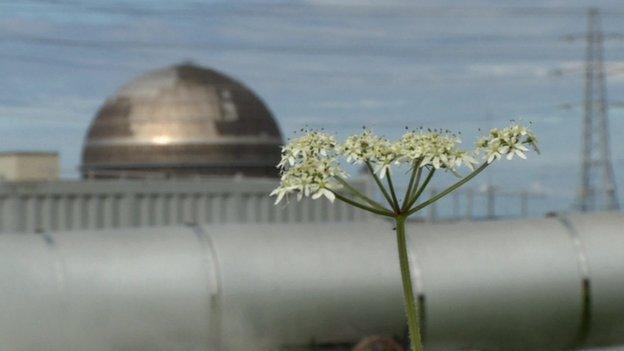
The clean-up of Sellafield's nuclear waste is only just getting under way, says Theo Leggett
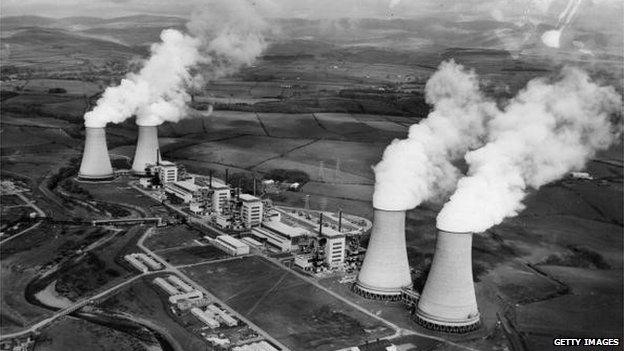
Britain's first nuclear power station, Calder Hall, was opened in 1956
Now, though, the plant is winding down. Apart from waste storage, all of its major activities are due to cease over the next few years.
Cleaning up the mess left behind is a major challenge.
"I'd love to be able to say to you that we've got very good records of all the material that we have in these facilities," says Kevin Gunston of Sellafield Ltd, the company responsible for the decommissioning process.
"But that just isn't the case. So one of the challenges we have is to understand exactly what material we have and where it is, so we know what we can do with it in the future".
Robot submarines
That's where the submarines come in.
Much of the waste that accumulated at Sellafield over the decades was stored underwater, in giant open air tanks, known as ponds. It included used fuel waiting to be reprocessed, contaminated materials and other discarded machinery.
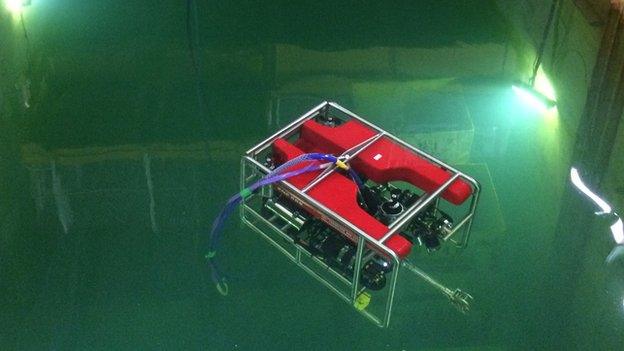
The tethered robots can swim and film underwater
But corrosion and spillages meant the water became murky, and the bottom of the ponds became covered with a thick layer of highly radioactive sludge and debris.
To find out what is down there and start to get rid of it, Sellafield Ltd has been using a fleet of mini-submarines, or Remotely Operated Underwater Vehicles (ROVs).
The smallest models can almost be held in the palm of your hand. They are camera drones, designed for advanced reconnaissance.
"These are used for going into very congested areas, very high hazard areas," says Philip Toomey, ROV innovation manager at Sellafield.
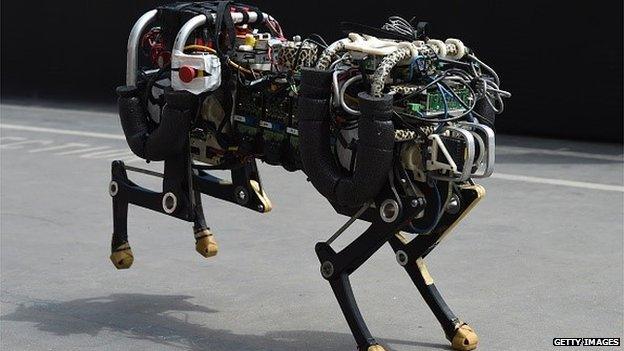
The 2011 Fukushima nuclear meltdown in Japan accelerated development of disaster response robots
"Some of these areas, we haven't been into for over 40 years".
Larger ROVs, about the size of a washing machine, are used for tasks such as removing old fuel rods from underwater skips, or sucking up sludge from the pond floor.
All of these machines have to be able to cope with very harsh conditions.
"The water itself is very acidic, and of course there's lots of radiation and contamination," says Mr Toomey.
Resilient design
One of the companies developing the subs on behalf of Sellafield is James Fisher Nuclear. Much of the technology it uses is adapted from systems already employed in the offshore oil and gas industries.
"It's more cost-effective if we can use off-the-shelf designs where possible," says Simon Pyne, the company's business development manager.
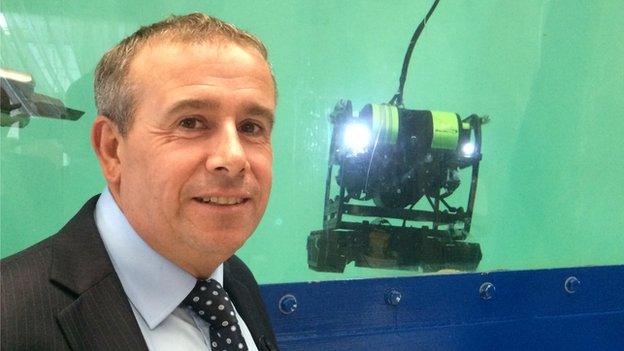
Simon Pyne, of James Fisher Nuclear, stands in front of one of his firm's submarine robots
"It's also much quicker than developing something from scratch."
He adds that it's surprising just how resilient bought-in designs can be to the high levels of radiation in the water.
Chimney challenge
But clean-up challenges at Sellafield are not confined to the storage ponds. Some of the other buildings on the site also represent unique challenges.
The skyline above the plant, for example, is dominated by a single tall chimney. It is one of two constructed to ventilate the original Sellafield reactors - the infamous Windscale Piles.
Its twin was demolished more than a decade ago, but this one remains standing. It was heavily contaminated during the 1957 fire, when a plume of radioactive smoke poured up it from the burning reactor core.
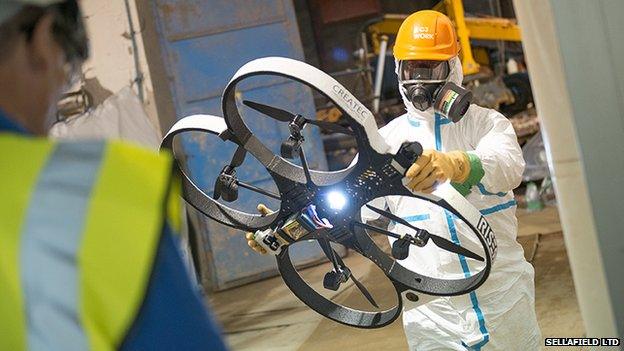
Drones can inspect areas of high radiation that would be dangerous for humans
Now, demolition works have begun, but the contractors have to be careful, because parts of the building are still radioactive. So to find out more, they're using a drone.
The Riser (Remote Intelligence Survey Equipment for Radiation) is a quadcopter equipped with systems that allow it to navigate inside a building, without GPS. It also has radiation sensors, which enable it to build up a 3D map of the inside of the chimney, with contamination picked out in bright colours.
The drone, a collaboration between Cumbrian firm Createc and Bedfordshire-based Blue Bear Systems Research, has already been tried out successfully inside the chimney and will be used in other parts of the plant as well.
Theo Leggett reports from Sellafield on new technology that is helping clean up industrial pollution
The radiation-mapping technology, meanwhile, has already been employed overseas - inside the heavily-contaminated Fukushima Daiichi plant in Japan.
Tried and tested
Not all the robots being put through their paces in and around Sellafield are so obviously cutting-edge, however.
On a test rig at the nearby National Nuclear Laboratory facility, three giant orange robot arms are being put through their paces. They are tearing apart rusty drums, bits of masonry and bars of unidentified metal, before packing the remains into shiny new containers.
If the robots work as intended, they'll eventually be taken to Sellafield where they'll process nuclear waste recovered from ponds and silos across the plant, preparing it for long-term storage.
Made by German specialist Kuka, they were originally developed for use in the car industry, and have been modified for their new task.
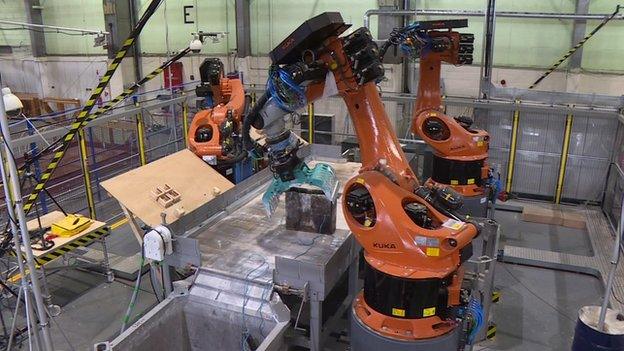
Giant robotic arms could be used to tear up and pack up contaminated equipment in future
Well-proven technology is absolutely vital as servicing and repair becomes very difficult once these machines have been handling contaminated material.
For the moment, all of these technologies are being developed and refined primarily to help in the clean-up at Sellafield - a process that is expected to take up to 100 years to complete.
But nuclear decommissioning is a headache shared by many western nations, so the expertise being gathered here could find lucrative new markets abroad as well.